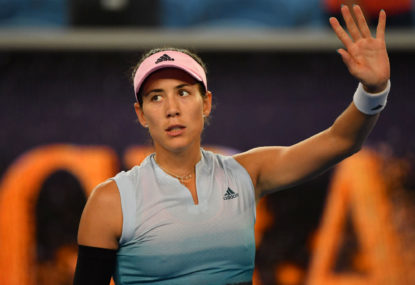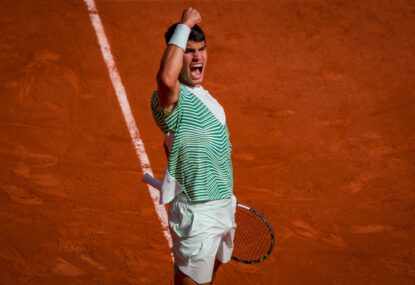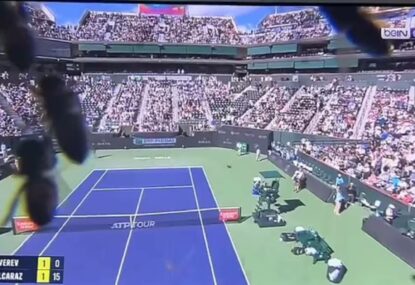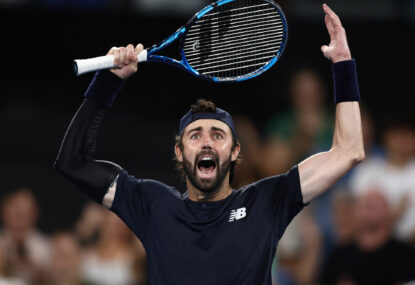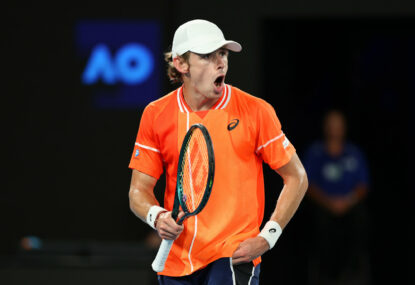As Wimbledon looms in just under a fortnight, here is a list of some of the biggest upsets that have taken place at SW19 in the past decade.
Wimbledon has seen its share of massive upsets and Cinderella stories over the past few years, with past champions falling early and unheralded players getting very far after entering the tournament with little expectation.
There could be disagreements over the order of upsets listed here, but these are the top 10 greatest upsets at Wimbledon in the past decade:
10. Sabine Lisicki defeats Li Na, second round, 2011
Three years after Zheng Jie’s Cinderella run to the semi-finals of the competition, her compatriot, the more successful Li Na, was on the wrong end of German player Sabine Lisicki’s dream run in 2011.
Whereas Zheng defeated the reigning French Open champion Ana Ivanovic en route to reaching the semi-finals, losing to the eventual runner-up Serena Williams, this time it was Li Na, who entered as the reigning champion from Paris, who was on the receiving end of an eventual run to the semis by Lisicki.
However, unlike Zheng’s straight sets victory back in 2008, Li Na actually put in an effort and held match point in the third set before capitulating to an 8-6 scoreline.
Li’s exit continued the trend of Roland Garros champions performing poorly at Wimbledon – exactly a year to the day after Ana Ivanovic’s demise in 2008. Svetlana Kuznetsova fell, ironically, to Lisicki in the third round at SW19 in 2009, and Francesca Schiavone fell on the first day of Wimbledon in 2010 to Vera Dushevina.
And so Lisicki did exactly what Zheng Jie did three years ago – knock off the reigning French Open champion en route to making the semi-finals, and losing to the eventual runner-up. Lisicki ran out of gas in the final four, losing to Maria Sharapova, who would then lose the final to Petra Kvitova.
Lisicki also seems to have a habit of defeating French Open champions at Wimbledon – she defeated Kuznetsova and Li in the aforementioned occasions, and last year shocked Maria Sharapova at the gates to the quarter-finals.
But there definitely won’t be an upset this year – Serena Williams is simply unstoppable at the moment and it would require a miracle for her to be taken down as she seeks title number six at the All England Club.
9. Marat Safin defeats Novak Djokovic, second round, 2008
Entering Wimbledon in 2008, Novak Djokovic was considered to be a big threat for the title at SW19.
The Serbian had reached the semi-finals of his last five Grand Slam tournaments, and had broken through to win his first Grand Slam title at the Australian Open early in 2008.
But after defeating Michael Berrer in the first round, he faced one of the most dangerous floaters in the draw, in the form of unseeded former World No. 1 and two-time Grand Slam champion Marat Safin.
In their previous meeting, the then-World No. 4 Safin easily thrashed Djokovic, who had just qualified for his first Grand Slam tournament, in the first round of the 2005 Australian Open, en route to winning the title.
This time, though, Djokovic was the favourite against Safin, whose ranking had since dropped to World No. 75. The Russian hadn’t reached the quarter-finals of a Grand Slam tournament, let alone win a single title, since then.
But Safin would repeat the dose on Djokovic, winning in straight sets and thus stopping the Serbian’s Grand Slam semi-final streak at five. Safin then carried on the momentum from his victory to eventually reach the semi-finals, where he found Roger Federer too good for him.
Since then, Djokovic has fallen in the early rounds of a Grand Slam tournament just once (2009 French Open), and has added five more titles to his impressive Grand Slam resume, including the Wimbledon crown in 2011. He is also on a current streak of 16 straight semi-finals, dating back to 2010.
While Safin never reached the same heights of the early noughties, it was a significant victory as the Russian would eventually end his Grand Slam quarter-final drought and reach the semis at his least favourite tournament for the first and only time in his career.
8. Maria Sharapova defeats Serena Williams, final, 2004
This could go down in history as the loss that spurred Serena Williams to her ongoing, endless domination of Maria Sharapova.
Entering the 2004 Wimbledon final, Williams was going for an unprecedented hat-trick of titles at SW19, but had suffered an injury-ravaged 2003 and 2004 that saw her ranking drop outside the top five.
However, her chances of a third title were very high, considering the fact that she did not have to face her sister, Venus, in the final, after the latter was defeated earlier in the tournament (see #2 below).
But in the final, she well and truly met her match. Maria Sharapova, a 17-year-old Russian still completing high school, shocked the Centre Court crowd when she took the first set in a breadstick, 6-1.
Sharapova was here to play and not muck around.
Though Serena appeared to bounce back, taking a 4-2 lead in the second set, Sharapova would reel off four consecutive games to complete the most stunning of Wimbledon upsets in recent history.
“To tell you the truth, I don’t know what happened in the match,” Sharapova said after achieving what would eventually be a quarter of her Career Grand Slam. “I don’t know how I won. I don’t know what the tactics were. I was just playing. I was in my own little world.”
Sharapova would only defeat Williams once more, in the final of the year-end championships later that year, before Serena started her total domination of the Russian, winning 13 straight matches against her, a streak which was only recently increased by her victory over Sharapova in the French Open final just recently.
7. Lu Yen-hsun defeats Andy Roddick, fourth round, 2010
Of all the losses that Andy Roddick has ever suffered at Wimbledon throughout his playing career, this one has got to rank as one of his most frustrating, outside of the hat-trick of final defeats he suffered at the hands of Roger Federer in 2004, 2005 and 2009.
Roddick appeared to be headed for another deep run at his favourite Grand Slam tournament outside of the US Open. However, that was until he ran into unheralded Taiwanese player Lu Yen-hsun, who had only gone past the second round of a Grand Slam tournament just once, at the 2009 Australian Open, and who had lost to Roger Federer in the first round at Wimbledon that same year.
Roddick took the first set easily and a routine victory was on the cards. However, Lu would take the next two sets in tiebreaks, before Roddick took the next in another tiebreak, before being cheered on as he tried to get past his Taiwanese opponent in the final set.
Unfortunately, the final set went 9-7 in Lu’s favour, and that advanced him to his first (and so far, only) Grand Slam quarter-final, where he ultimately lost to Novak Djokovic.
As for Roddick, he was never the same player thereafter. He would never reach the quarter-finals at the All England Club again, and would only reach one more Grand Slam quarter-final, at the US Open in 2011, losing to Rafael Nadal.
6. Marion Bartoli defeats Serena Williams, fourth round, 2011
Serena Williams entered Wimbledon in 2011 as the two-time defending champion, but also with her ranking having dropped to 25 following almost 12 months out of the sport with a cut foot and a near-death experience.
She managed to reach the fourth round of Wimbledon for the fifth year in succession, as had been customary given her impressive record at SW19. Facing her on the opposite side of the net for a place in the quarter-finals was none other than Marion Bartoli, who had reached the final in 2007 but lost to Venus Williams.
Serena had defeated Bartoli in their only previous meeting, at the 2007 US Open, but this was a big victory for the Frenchwoman.
Bartoli won in straight sets, in the process going on to reach the quarter-finals, where she lost to Sabine Lisicki in a match played in thunderous conditions. While this might be Bartoli’s only ever career victory against Williams, it was significant as it came on grass, which historically has been the American’s best surface.
For Williams, though, the defeat meant that she dropped to World No. 175, because she had so many points to defend as the two-time reigning champion.
But it wouldn’t take long for her to regain her best form, as she would reach the US Open final two months later, taking out past (Ana Ivanovic), present (Caroline Wozniacki) and future (Victoria Azarenka) World No. 1’s en route.
Last year, she captured her fifth title at SW19 by defeating Agnieszka Radwanska in the final, in three sets, thus restoring order to the tournament after the previous year’s early exit.
5. Tomas Berdych defeats Roger Federer, quarter-finals, 2010
This was an upset that nobody saw coming in 2010, though it was inevitable that Roger Federer would one day have to be taken down at Wimbledon, after seven straight finals, and so it happened.
Many thought that Roger Federer was invincible on grass, as the Swiss player had only lost one match at the All England Club since 2002 – that being the epic final against Rafael Nadal in 2008.
Federer entered Wimbledon that year as one of the favourites, despite having lost in the Halle final to long-time rival Lleyton Hewitt in the lead up, as well as his World No. 1 ranking to Nadal after losing in the quarter-finals of the French Open.
Federer looked headed for his earliest exit in London since 2002 when he fell two sets to love down against Alejandro Falla in the first round. He also faced the task of having to break Falla as the Colombian served for the match, but Federer eventually broke through and won the final set 6-0.
But from there it was easy going until he met Tomas Berdych in the quarter-finals. The Czech had already gotten the better of him in Miami; it was his first victory over Federer since claiming his scalp at the Athens Olympics in 2004.
Berdych claimed a stunning four-set victory to sentence Federer to a second straight Grand Slam quarter-final exit and ensure that the final would not feature the great Swiss, or Andy Roddick, for the first time since 2002.
As for Berdych’s part, he would go on to knock off Novak Djokovic in the semi-finals before losing to Rafael Nadal in the final. It would take Federer two years to restore order at Wimbledon, when he won his seventh title at the expense of Andy Murray in the final last year.
4. The Top Four women, early rounds, 2008
While the 2008 tournament was best remembered for the epic final between Roger Federer and Rafael Nadal, as well as the all-Williams showdown for the women’s title, the women’s tournament is best known as being the worst performance by the top four seeds, collectively, at a Grand Slam tournament in the Open Era.
It was thought that the top four seeds, Ana Ivanovic, Jelena Jankovic, Maria Sharapova and Svetlana Kuznetsova, would start the next era of dominance in women’s tennis, following the retirement of Justine Henin in May 2008.
Over the last 12 months, all but Kuznetsova had reached the semi-finals of the French Open in 2007 and the Australian Open in 2008. All four reached the semi-finals at Indian Wells the same year, and all but Sharapova had just recently reached the semi-finals of the French Open, which Ivanovic won.
But nobody saw their collective demise coming at Wimbledon.
The carnage started on the tournament’s fourth day when Maria Sharapova suffered her earliest ever exit at Wimbledon, as Alla Kudryavtseva shocked her in the second round.
This was followed by a Centre Court stunner 24 hours later, as Ana Ivanovic went down to China’s World No. 133, Zheng Jie, just 20 days after she lifted the Coupe Suzanne Lenglen as the French Open champion.
And it didn’t stop there. On “Magic Monday”, as it’s known at Wimbledon, Jelena Jankovic’s attempts to restore order were banished by Thai veteran Tamarine Tanasugarn, who went on to reach her first (and only) Grand Slam quarter-final, while Svetlana Kuznetsova was pipped in three sets by Agnieszka Radwanska, who had defeated her easily at the Australian Open earlier that year.
This completed the worst ever performance by the top four seeds at any Grand Slam event in the Open Era. Amazingly, Radwanska was the only player seeded between 13 and 16 who actually got to the quarter-finals, by virtue of her victory over Kuznetsova, the second of three she achieved over the Russian that year.
As for the conquerors of each of the Top Four – Kudryavtseva could not convert her victory over Sharapova into a quarter-final, being stopped by Nadia Petrova in the fourth round, Tanasugarn and Radwanska were each stopped by the Williams sisters in the quarter-finals and Zheng made a run to the final four, where she eventually found Serena Williams too good for her.
Since then, the top four never dominated as a group again.
There would be no repeat 12 months later, as each of the Top Four would reach the semi-finals in 2009 (the Williams sisters, Dinara Safina and Elena Dementieva).
3. Ivo Karlovic defeats Lleyton Hewitt, first round, 2003
This was perhaps one of the greatest upsets ever inflicted upon a former champion at Wimbledon.
Lleyton Hewitt hadn’t been enjoying a great 2003 season by his standards and had just split from his long-time coach, Jason Stoltenberg, shortly after the French Open.
Entering the defence of his Wimbledon title, Hewitt appeared in good shape, having just hired Roger Rasheed in a partnership which would last for the next three-and-a-half years.
Opposing him on the tennis court to open his title defence would be a Croatian qualifier called Ivo Karlovic, still best known today for his towering appearance and his serve.
After Hewitt took the first set in just 19 minutes, things appeared well on track. Well, that was until Karlovic started serving like never before and worked his way into the match. He took the second set in a tiebreak, and Hewitt never recovered.
Karlovic then took the next two sets to complete a stunning victory, thus adding Hewitt’s name to a list of players who lost in the first round of their Grand Slam title defences, the Australian joining the likes of Pat Rafter and Boris Becker in the hall of shame.
Many could argue that Hewitt was never the same player after that defeat. But in the 24 months that followed, the Australian would reach the final of the US Open in 2004, as well as the final of the Australian Open in 2005, falling short on both occasions to Roger Federer and Marat Safin, respectively.
Even so, Hewitt never reached the same heights as he did in 2001 and 2002 again.
2. Karolina Sprem defeats Venus Williams, second round, 2004
As far as upsets go at Wimbledon, this is one that will be remembered for a long time, not just for Karolina Sprem’s victory, but also for the controversial nature in which it happened.
Venus Williams had reached the finals at SW19 in each of the last four years, winning the title in 2000 and 2001, while losing the last two finals to her younger sister, Serena.
Williams was not expected to be challenged when she met 19-year-old Croat Karolina Sprem in the second round of the 2004 edition.
But the Croat, who had lost to Williams in Berlin after leading 3-0 in the final set, played brilliantly to take the first set in a tiebreak, as an upset loomed large.
Then came the controversial second set tiebreak, when Sprem was incorrectly awarded a point while trailing 1-2. Neither player picked up on the error, though Venus eventually broke to gain three set points, each of which she wasted.
Sprem then came through to earn the biggest victory of her career, and thus send Williams crashing to her earliest exit at SW19 since 1997.
The Croat would go on to reach the quarter-finals for the only time in her career, where she eventually went down to Lindsay Davenport. Sprem was the only unseeded quarter-finalist in the 2004 edition.
As for Williams, though, the defeat would not affect the rest of her playing career at Wimbledon. She would bounce back to win the title in 2005, and earn two more crowns in 2007 and 2008, before losing the 2009 final to Serena Williams – incidentally also the last time Venus would feature in a final at Wimbledon.
A quarter-final in 2010 would follow, but since then she has not gone past the fourth round in London. Further, she hasn’t reached the quarter-finals of any Grand Slam tournament since losing to Kim Clijsters in the semi-finals of the 2010 US Open, suggesting that her career could soon come to a close.
1. Lukas Rosol defeats Rafael Nadal, second round, 2012
Yes, you guessed it – Lukas Rosol’s stunning five-set victory over Rafael Nadal at last year’s Championships tops the list.
The then very little-known Czech had previously tried to qualify for the main draw at the All England Club five times, but was unsuccessful each time.
However, his ranking while entering the third Grand Slam of 2012 was high enough to warrant direct entry into the main draw, and after five previous attempts, Rosol made his debut in the main draw of the 2012 Wimbledon Championships at the age of 26.
In his first match, Rosol defeated Ivan Dodig, and thus set up a second round match against World No. 2 and recently-crowned seven-time French Open champion Rafael Nadal (who has since won an eighth title in Paris), which was to be played on Centre Court.
Most experts unanimously tipped Nadal to win, and after he won the first set, albeit in a tiebreak, things were going well as expected.
But then, Lukas Rosol started to put him under all sorts of pressure, and took the next two sets to take a surprise two-set-to-one lead entering the fourth set.
Nadal then restored order by taking the fourth set, but Rosol would unleash in the fifth set, holding his last two service games to love to complete what will go down as one of the greatest upsets in Wimbledon history.
Rosol’s stunning victory thus had serious ramifications in regard to Nadal’s half of the draw. Jo-Wilfried Tsonga, who would have met the Spaniard in the quarter-finals, now had an easy path to the semi-finals and Andy Murray, the would-be semi-final opponent of Nadal, now had an easier path to becoming Britain’s first male finalist at Wimbledon since Bunny Austin in 1938.
Ultimately, Murray would reach the final, where he would go down fighting in four sets to Roger Federer. This would mark a turning point in the Brit’s career, as he went on to defeat Federer at Wimbledon exactly four weeks later, albeit for a different prize – the Olympic gold medal, and then win his first Grand Slam title by defeating Novak Djokovic in the final of the US Open.
As for Nadal, the loss spelt the end of the Spaniard for the year. He was forced to concede the defence of his Olympic gold medal which he won in Beijing in 2008, and would not be seen again until just after the 2013 Australian Open; by then, his world ranking had dropped to No. 5.
Rosol’s victory would set the precedence for him to win his first ATP title in Bucharest, and reach a career high ranking of World No. 33.






























































































